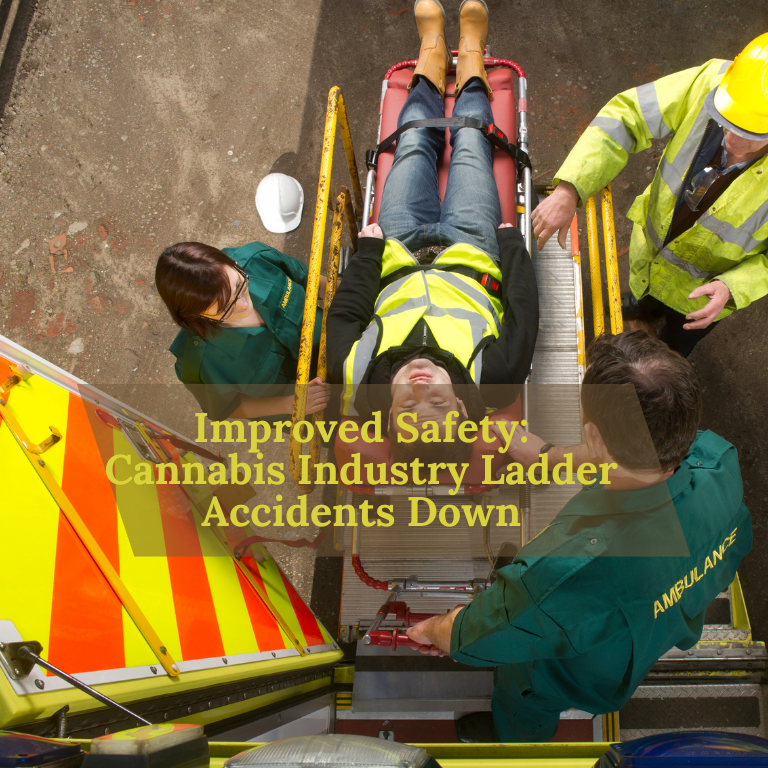Improved Safety Standards: The Cannabis Industry Sees Decline in Ladder-Related Accidents
The cannabis industry is not only growing in terms of market size and innovation but also in workplace safety standards. One remarkable trend is the significant decline in ladder-related accidents, an often-overlooked aspect of occupational safety in the cultivation and processing sectors of this booming industry.
This article delves into how improved safety measures, industry-wide initiatives, and innovative practices have contributed to this reduction, highlighting the importance of safety in maintaining sustainable growth and employee well-being.
The Role of Ladders in the Cannabis Industry: A Critical Tool with High Risks
Ladders are an indispensable tool in the cannabis industry, particularly in cultivation facilities. These tools are used for a range of activities, from harvesting plants in vertical grow systems to maintaining lighting and HVAC systems. However, their frequent use also makes them a common source of workplace injuries.
The cannabis sector, which has historically been regulated more loosely than traditional agriculture or manufacturing, faced an uphill battle in implementing standardized safety protocols for ladder use.
A History of Safety Challenges in the Cannabis Industry
The rapid legalization and expansion of cannabis markets created a landscape where businesses raced to meet demand, sometimes at the expense of workplace safety. Many companies were focused on scaling operations, often overlooking or underfunding comprehensive safety programs.
Ladder-related accidents were among the most common incidents reported, with falls accounting for a significant percentage of injuries in cultivation facilities.
Unique Safety Risks in Cannabis Cultivation
Unlike traditional agriculture, cannabis cultivation often involves vertical farming systems. These setups maximize space efficiency but require workers to operate at various heights, increasing the reliance on ladders. Poor ladder placement, lack of training, and inadequate equipment maintenance further compounded the risks.
The Turning Point: Industry-Wide Focus on Safety Regulations
The cannabis industry’s shift toward improved safety standards gained momentum with increased regulatory oversight and the establishment of industry-specific guidelines. This transformation can be attributed to several factors:
Enhanced OSHA Guidelines and Compliance
The U.S. Occupational Safety and Health Administration (OSHA) began focusing more on the cannabis industry as it grew. OSHA introduced specific training requirements and compliance checks for cultivation facilities, emphasizing ladder safety as a priority.
Safety Certification Programs
Programs such as Good Manufacturing Practices (GMP) and Good Agricultural Practices (GAP) certification gained traction in the cannabis sector. These certifications encouraged companies to adopt comprehensive safety protocols, including the proper use and maintenance of ladders.
How Training Programs Have Reduced Ladder-Related Accidents
Employee training has been one of the most effective tools in reducing ladder-related incidents. Many companies now provide specialized training that focuses on:
Proper ladder selection for specific tasks.
Correct ladder positioning to avoid instability.
Safe climbing and descending techniques.
Training sessions also cover risk assessment, teaching employees to identify and mitigate hazards before using a ladder.
Technology-Enhanced Safety Education
Innovative companies have embraced technology to improve safety education. Virtual reality (VR) simulations, for instance, allow workers to practice ladder safety in a controlled environment, reducing the likelihood of accidents in real-world scenarios.
Equipment Innovations: A Game-Changer for Ladder Safety
Advancements in ladder design have contributed significantly to improved safety. Modern ladders used in cannabis facilities now feature:
Non-slip steps and platforms.
Sturdier materials to prevent structural failures.
Adjustable heights to accommodate various tasks.
These improvements not only reduce the risk of falls but also enhance worker confidence and efficiency.
Alternative Solutions: Reducing Ladder Dependency
Some companies have invested in alternatives to ladders, such as scissor lifts and mobile platforms. These tools provide safer and more stable options for accessing elevated areas, particularly in large-scale cultivation facilities.
The Impact of Improved Safety Culture on the Cannabis Industry
Safety has become a core value in the cannabis industry, with many businesses adopting a proactive approach to workplace hazards. Companies now prioritize regular safety audits, employee feedback, and continuous improvement in their safety programs.
Lower Injury Rates and Financial Benefits
The decline in ladder-related accidents has translated into measurable benefits, including:
Reduced workers’ compensation claims.
Fewer disruptions to operations due to employee injuries.
Enhanced productivity and morale among workers.
The Role of Industry Advocacy in Promoting Safety Standards
Industry organizations and advocacy groups have played a critical role in driving the safety conversation. Groups like the National Cannabis Industry Association (NCIA) have hosted seminars, shared best practices, and lobbied for regulations that prioritize worker safety.
These efforts have fostered a collaborative environment where businesses can learn from each other and collectively raise the bar for safety standards.
Challenges That Remain in Maintaining Ladder Safety
Despite the progress, challenges remain:
Compliance Gaps: Smaller companies with limited resources may struggle to implement comprehensive safety programs.
Evolving Regulations: As the cannabis industry continues to grow, businesses must stay ahead of changing safety requirements.
Cultural Resistance: Shifting attitudes toward safety in fast-paced, high-pressure environments can take time.
Future Directions: The Next Frontier in Workplace Safety
The integration of automation and robotics in cannabis facilities could further reduce the need for ladders and other high-risk equipment. Automated systems for planting, harvesting, and maintenance are becoming more accessible, offering safer alternatives to manual labor at heights.
Data-Driven Safety Strategies
Data analytics is emerging as a powerful tool for identifying safety trends and predicting potential hazards. By analyzing accident data, companies can develop targeted interventions to further reduce ladder-related risks.
A Safer Future for the Cannabis Industry
The decline in ladder-related accidents is a testament to the cannabis industry’s commitment to safety and its ability to adapt to regulatory and operational challenges. As companies continue to invest in training, equipment, and innovative solutions, the industry is setting a new standard for workplace safety.
By prioritizing the well-being of its workforce, the cannabis sector not only enhances productivity and growth but also builds a foundation of trust and sustainability for the future.













